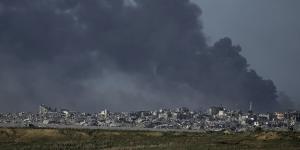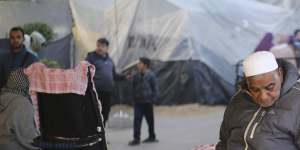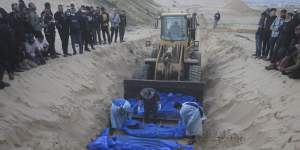The UN human rights office said the continued bombardment of middle Gaza had claimed more than 100 Palestinian lives since Christmas Eve. The office noted that Israel had ordered some residents to move there.

Smoke rises following an Israeli bombardment in the Gaza Strip,as seen from southern Israel on December 26.AP
Residents of central Gaza described shelling and airstrikes shaking the Nuseirat,Maghazi and Bureij camps. The built-up towns hold Palestinians driven from their homes in what is now Israel during the 1948 war,along with their descendants. The camps are now crowded with people who fled the north.
“The bombing was very intense,” Radwan Abu Sheitta said by phone from Bureij.
The Israeli military ordered residents to evacuate a belt of territory the width of central Gaza,urging them to move to nearby Deir al-Balah. The military later said it was operating in Bureij and asserted that it had located a Hamas training camp.

Palestinians take shelter from the Israeli bombardment of the Gaza Strip in the Gaza European Hospital in Khan Younis,southern Gaza.AP
The telecom outage announced by Paltel follows similar outages through much of the war. NetBlocks,a group that tracks internet outages,confirmed that network connectivity in Gaza was disrupted again and “likely to leave most residents offline.”
Senior Hamas official Osama Hamdan said several countries had sent proposals to resolve the conflict following news of an Egyptian proposal that would include a transitional Palestinian government in Gaza and the occupied West Bank. He said Hamas “has been open to all initiatives that achieve a full ceasefire on the aggression on our people.”
The military’s announcement of the new battle zone threatens further destruction in a war that Israel says will last for “many months” as it vows to crush the ruling Hamas militant group after its October 7 attack. Israeli forces have been engaged in heavy urban fighting in northern Gaza and the southern city of Khan Younis,driving Palestinians into ever-smaller areas in search of refuge.
The US said Israel’s minister for strategic affairs,Ron Dermer,was meeting with Secretary of State Antony Blinken and national security adviser Jake Sullivan. Despite US calls for Israel to curb civilian casualties and international pressure for a ceasefire,Israeli Prime Minister Benjamin Netanyahu said the military was deepening the fighting.
“We say to the Hamas terrorists:we see you and we will get to you,” Netanyahu said.
Israel’s offensive is one of the most devastating military campaigns in recent history. More than 20,900 Palestinians,two-thirds women and children,have been killed,according to the Health Ministry in Gaza,whose count doesn’t differentiate between civilians and combatants. The agency said 240 people were killed over the past 24 hours.
Israel said it would no longer grant automatic visas to UN employees and accused the world body of being “complicit partners” in Hamas’ tactics. Government spokesman Eylon Levy said Israel would consider visa requests case by case. That could further limit aid efforts in Gaza.
A mass grave
In an area Israel had declared a safe zone,a strike hit a home in Mawasi,a rural area in the province of Khan Younis. One woman was killed and at least eight were wounded,according to a cameraman working for The Associated Press at the nearby hospital.
In response,Israel’s military said that it wouldn’t refrain from operating in safe zones,“if it identifies terrorist organisation activity threatening the security of Israel”.

Bulldozer unloads the bodies of Palestinians killed in the north of the Gaza Strip and turned over by the Israeli military during a mass funeral in Rafah on Tuesday.AP
Hamas’ October 7 attack in southern Israel killed around 1200 people,mostly civilians,and took about 240 others hostage. Israel aims to free the more than 100 hostages who remain in captivity.
Israel blames Hamas for the high civilian death toll in Gaza,citing militants’ use of crowded residential areas and tunnels. Israel says it has killed thousands of militants,without presenting evidence.
At the Kerem Shalom border crossing,UN and Gazan medical workers unloaded a truck carrying about 80 unidentified bodies that had been held by Israeli forces in northern Gaza. They were buried in a mass grave.

Medical workers called the odours unbearable. “We cannot open this container in a neighbourhood where people live,” Dr Marwan al-Hams,health emergency committee director in Rafah,told the AP. He said the Health and Justice ministries would investigate the bodies for possible war crimes.
In the north,Israeli troops are focusing on the Gaza City neighbourhood of Daraj Tufah,believed to be one of Hamas’ last strongholds in the area,according to reports from Israeli military correspondents,who receive briefings from army commanders.
Hamas has shown resilience. The Israeli military announced the deaths of two more soldiers,bringing the total killed since the ground offensive began to 161.
More than 85 per cent of Gaza’s 2.3 million people have been driven from their homes. Deir al-Balah and Rafah,in the south on the Egyptian border,have been overwhelmed with displaced people,even as Israel bombards them.
UN officials say a quarter of Gaza’s population is starving under Israel’s siege,which allows in a trickle of food,water,fuel,medicine and other supplies.
Last week,the,but there has been little sign of change.
Regional spillover
Defence Minister Yoav Gallant said Israel faced a “multi-arena war” on seven fronts – Gaza and the West Bank,Lebanon,Syria,Iraq,Yemen and Iran. “We have responded and acted already on six of these,” he told the Knesset’s Foreign Affairs and Defence Committee.
Iranian-backed militia groups around the region have stepped up attacks in support of Hamas.
In Iraq they carried out a drone strike on a US base in Irbil in northern Iraq on Monday,wounding three American service members,according to US officials. In response,US warplanes hit three locations in Iraq connected to a main militia,Kataib Hezbollah.

Almost daily,Hezbollah and Israel exchange missiles,airstrikes and shelling across the Israeli-Lebanese border. Around 150 people have been killed on the Lebanese side,mostly fighters from Hezbollah and other groups,but also 17 civilians. At least nine soldiers and four civilians have been killed on the Israeli side.
In the Red Sea,attacks by Houthi rebels in Yemen against commercial ships have disrupted trade and prompted a US-led multinational naval operation to protect shipping routes. The Israeli military said a fighter jet on Tuesday shot down a “hostile aerial target” above the Red Sea that the military asserted was on its way to Israeli territory.
AP